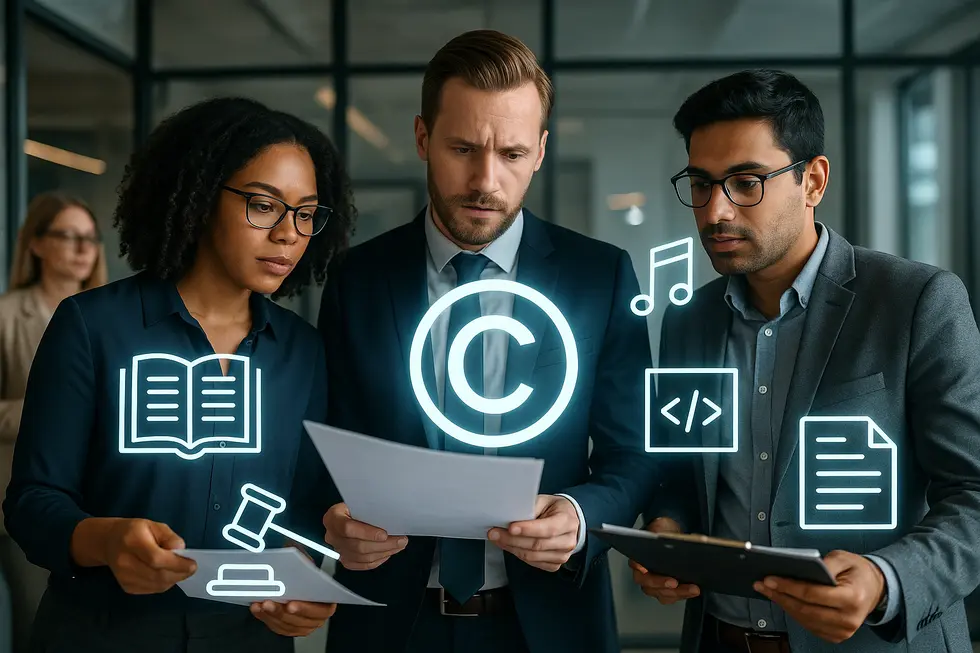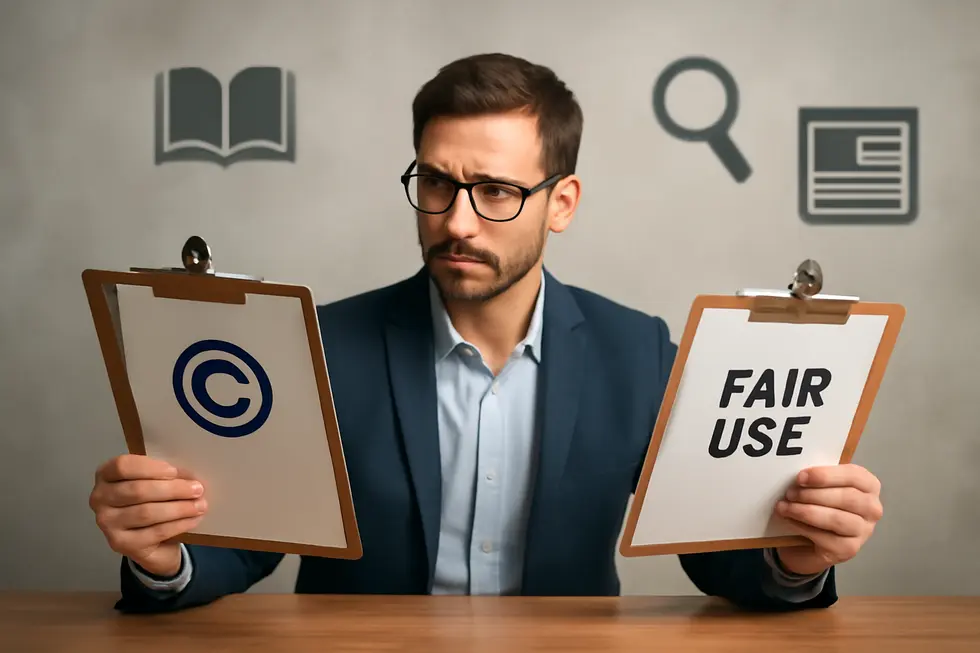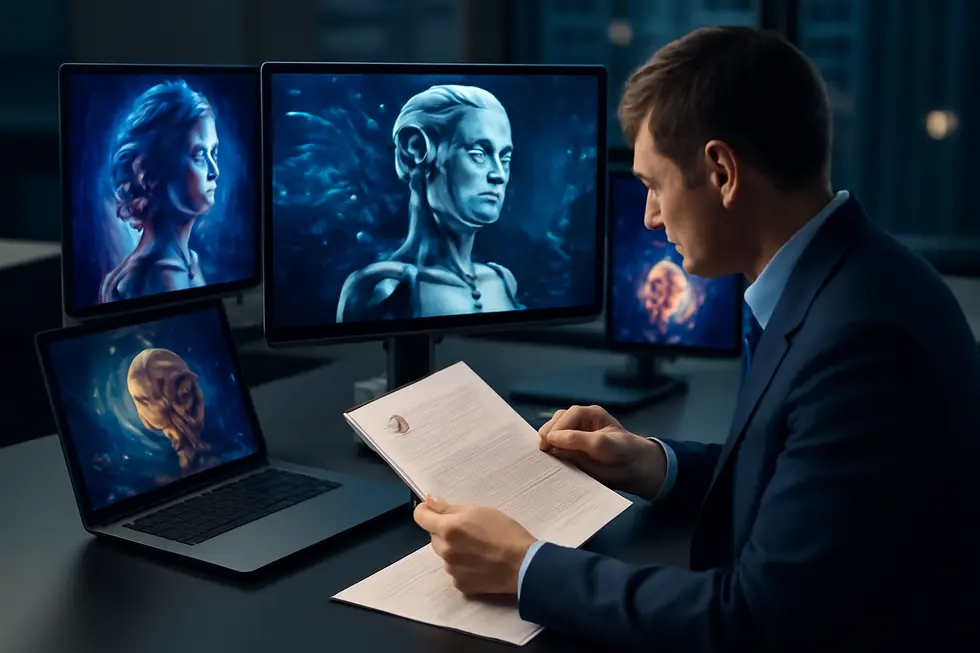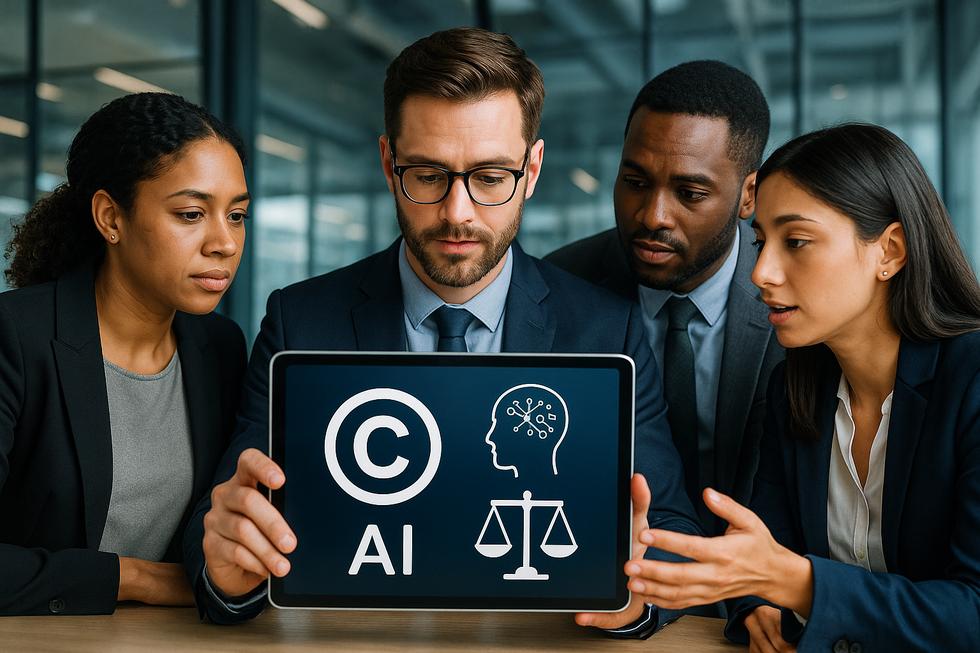Introduction
Copyrighted material forms the backbone of creative and intellectual assets that many businesses rely upon daily. For business owners, navigating copyright law is indispensable—not only to protect their own creations but also to responsibly use the copyrighted content of others. Understanding the legal protections automatically granted to original works, the nuanced applications of fair use, and the emerging challenges posed by artificial intelligence helps businesses avoid costly infringements and leverage content effectively. This foundation begins with a clear grasp of the legal framework governing copyrighted material, followed by a deep dive into the fair use doctrine and its applicability in business contexts. Finally, recognizing how AI-generated content interacts with copyright law equips businesses to innovate responsibly in a rapidly evolving digital environment.
Tables of Contents
Chapter 1: Legal Framework and Protection of Copyrighted Material
- Global Treaties and Regional Variations Shaping Copyright Protection Across Borders
- National Copyright Laws and Enforcement: Safeguarding Creative Rights in a Digital Age
- Balancing Exclusive Rights and Limitations: The Economic Dynamics of Copyright Protection
Chapter 2: Fair Use Doctrine and Its Application to Copyrighted Material
- Navigating the Digital Frontier: How Technology Reshapes Fair Use in Copyright
- Balancing Innovation and Creator Interests: The Economic Dynamics of Fair Use
- Global and Cultural Dimensions Influencing the Fair Use Doctrine in Copyright
Chapter 3: Navigating the Legal Frontiers of AI and Copyrighted Material
- Key Court Decisions Shaping Copyright Law Amid AI Innovation
- Navigating the Legal and Economic Turbulence of AI-Trained Copyrighted Content
- Unraveling Societal Impact and Geopolitical Stakes in AI’s Interaction with Copyrighted Works
Chapter 1: Legal Framework and Protection of Copyrighted Material

1. Global Treaties and Regional Variations Shaping Copyright Protection Across Borders
International legal frameworks form the cornerstone of global copyright protection, harmonizing diverse national laws to safeguard creators’ rights worldwide. At the heart of this system lies the Berne Convention, a foundational treaty that ensures automatic protection of literary and artistic works across all its member countries without the need for formal registration. This convention also enshrines moral rights for authors and sets minimum standards that national laws must meet, creating a baseline for copyright protection that transcends borders.
Building upon these principles, the World Intellectual Property Organization (WIPO) Copyright Treaty (WCT) addresses the evolving challenges presented by digital technologies. It extends protections to computer programs, databases, and introduces legal obligations related to technological measures and rights management information. This treaty strengthens enforcement in the digital realm, highlighting the growing complexities of protecting copyrighted material in an era of rapid technological development.
Despite these international agreements, regional laws introduce significant variations that impact how copyright is enforced globally. For example, the United States’ Digital Millennium Copyright Act (DMCA) establishes a “safe harbor” framework which shields online platforms from liability for infringing user content, provided they act swiftly on valid takedown notices. While this legislation is national, its influence is far-reaching, given the global reach of U.S.-based online platforms and audiences.
Conversely, the European Union’s Copyright Directive imposes more stringent proactive responsibilities on digital service providers, requiring them to implement content recognition and filtering systems to prevent unauthorized use before it occurs. These contrasting approaches between reactive and preventive enforcement illustrate the legal complexity faced by multinational platforms striving to comply with multiple jurisdictions simultaneously.
Ongoing international cooperation, notably through WIPO, seeks to harmonize these differences by fostering stronger collaboration among nations and refining frameworks to address modern issues such as artificial intelligence-created content and cross-border digital distribution. Countries like Singapore exemplify commitment to these international standards, embedding treaty obligations within their national laws and employing comprehensive enforcement measures to protect intellectual property rights effectively.
Navigating this multifaceted legal landscape demands continuous adaptation. Copyright holders and platforms must stay informed of evolving treaty interpretations and regional directives while balancing enforcement and technological capabilities. For an insightful analysis on how international laws intersect with national statutes like the DMCA, see the PatentPC blog. This ongoing evolution ensures copyright protection remains robust across an increasingly interconnected global digital environment.
2. National Copyright Laws and Enforcement: Safeguarding Creative Rights in a Digital Age
National copyright laws form the cornerstone of protecting creators’ exclusive rights over original works. These laws grant authors control over reproduction, distribution, public display, adaptation, and other uses of their works. At the heart of national frameworks lies a balance between empowering creators and ensuring public access to creative content. Enforcement mechanisms embedded within these laws are vital to uphold this balance, deterring infringement and enabling rights holders to seek remedies.
A principal enforcement tool in many jurisdictions, notably the United States, is the notice-and-takedown system embodied in the Digital Millennium Copyright Act (DMCA). This framework offers a safe harbor for online platforms hosting user-generated content, shielding them from liability if they swiftly remove infringing materials upon receiving proper notices. The DMCA requires platforms to act diligently — once alerted to infringing content, they must expeditiously take it down or risk losing safe harbor protection. To maintain compliance, platforms must meticulously document takedown requests and any counter-notices, fostering transparency and accountability. While the DMCA originates in U.S. law, its influence extends globally, especially on platforms with broad international reach, posing challenges when conflicting national laws apply.
Beyond administrative processes, national statutes often empower courts to issue injunctions, award damages, and impose criminal penalties for willful infringement. These judicial remedies are crucial for cases where amicable resolution is impossible and where infringement causes significant harm. In parallel, businesses operating in international supply chains adopt legal strategies such as indemnification clauses, intellectual property insurance, and limitation of liability provisions to manage risks linked to copyright violations and trade secret breaches.
Navigating national enforcement is increasingly complex due to variations in legal standards and jurisdictional reach. Rights holders and digital platforms must carefully manage compliance to avoid liability while respecting creators’ rights. For copyright owners seeking a deeper understanding of foundational concepts, exploring the copyright definition for business owners is recommended.
Overall, national laws structure the protections and enforcement necessary to support creative industries, with frameworks like the DMCA exemplifying how enforcement adapts to the challenges posed by digital sharing and content accessibility. More on how international rules interact with these mechanisms can be found in the discussion on international copyright laws and their alignment or conflict with the DMCA.
3. Balancing Exclusive Rights and Limitations: The Economic Dynamics of Copyright Protection
Copyright law grants creators a set of exclusive economic rights that serve as the foundation for monetizing their original works. These rights include control over reproduction, distribution, public performance, and adaptations, enabling creators and rights holders to license their content, collect royalties, and maintain authority over commercial uses. Alongside these economic rights, moral rights protect the creator’s personal connection to their work, ensuring proper attribution and the prevention of derogatory alterations that might harm their reputation. Integral to the legal framework are also negative rights, which empower creators to prevent unauthorized exploitation of their works, forming a critical line of defense against infringement.
However, the scope of copyright protection is carefully circumscribed to balance the interests of creators with the public’s access to cultural resources and innovation opportunities. One key limitation is the fixed duration of copyright, generally lasting for the life of the author plus 70 years in the United States. This finite term ensures that, eventually, works enter the public domain where they can enrich society freely. Additionally, copyright protects only the expression of ideas, not the ideas themselves, allowing others to build upon concepts without copying protected content. User rights, while substantial, face constraints through licensing and legal restrictions, which can limit the ways content is used, modified, or shared—especially in highly controlled sectors like software. Furthermore, enforcing copyright faces challenges in the global digital environment, where rapid technological advances and cross-border distribution complicate the ability to control unauthorized use effectively.
Economically, copyright motivates creative investment by ensuring that creators and investors can recoup their efforts and expenses. This incentive promotes innovation across diverse fields such as literature, film, music, and software development. Yet, economic benefits often concentrate in intermediaries like publishers and digital platforms, raising concerns about the equitable distribution of earnings within creative industries. The framework also creates barriers for smaller entities, particularly startups, which may encounter costly licensing hurdles and legal complexities, restraining access to existing technologies and markets.
On an international scale, agreements like TRIPS standardize minimum protections, facilitating enforcement across borders but also drawing criticism for favoring developed economies and increasing consumer costs in less affluent regions. In sum, the legal framework of copyright weaves exclusive rights and strategic limitations into an economic system that incentivizes creativity while striving to maintain public access and fair use.
For further insight into how copyright shapes creative economies, refer to Trademark2Go’s coverage of copyright characteristics and economic impact.
Chapter 2: Fair Use Doctrine and Its Application to Copyrighted Material

1. Navigating the Digital Frontier: How Technology Reshapes Fair Use in Copyright
The rapid evolution of digital technology, particularly artificial intelligence (AI), has profoundly influenced the application of the fair use doctrine within copyright law. Traditional copyright principles are increasingly challenged by new methods of use and reproduction that technology enables, demanding that courts adapt fair use analysis to these emerging realities. At the core of this adaptation lies the recognition that transformative use, a vital factor in fair use consideration, must now be understood through the lens of digital innovation.
For instance, the training of large language models (LLMs) has brought forth landmark judicial views underscoring that ingesting copyrighted works to learn linguistic patterns is inherently transformative. It transcends mere replication by facilitating the generation of original content, which strongly supports fair use under the factor assessing purpose and character. This nuanced perspective acknowledges that the complete copying of works often becomes necessary in AI contexts, contrasting with older views favoring minimal use. However, courts remain sensitive to the origin of such materials—use of pirated or unauthorized content weighs heavily against fair use determinations.
The market impact factor is also evolving, expanding beyond direct harm to conventional sales. Courts now consider how AI-driven markets influence traditional industries, weighing the licensing interests of legacy publishers against the innovative potential of emerging technologies. This dynamic emphasizes that fair use judgments are inherently context-specific, resisting rigid formulas in favor of a balanced, case-by-case approach.
Another technological nuance involves distinguishing between data and creative expression. Copyright law protects only the original presentation or compilation of data, not the raw facts themselves. This distinction is critical in the age of big data, where technology companies process and repurpose massive datasets without monopolizing underlying factual information.
Ultimately, the integration of technology into the fair use doctrine underscores its flexible nature under 17 U.S.C. § 107. By emphasizing transformative purpose and contextual market evaluation, courts strive to promote innovation while safeguarding legitimate copyright interests. For business owners seeking to understand these intersections, exploring copyright information for books provides valuable insight into protected works and evolving digital usage.
For an in-depth legal analysis of these emerging themes, the arXiv paper on fair use and AI offers a comprehensive resource.
2. Balancing Innovation and Creator Interests: The Economic Dynamics of Fair Use
The Fair Use Doctrine plays a pivotal economic role in the landscape of copyrighted material, where it delicately balances creators’ financial interests with society’s demand for access and innovation. At its core, fair use provides limited permissions to reuse copyrighted works without prior authorization, but this latitude is carefully calibrated against potential market harm to the original materials. Courts weigh whether the use substitutes for the original or its derivative markets, as any significant erosion of licensing opportunities can directly diminish the revenue streams crucial for creators’ livelihoods. For instance, legal disputes like the Georgia State University e-reserve case have underscored the economic tension between facilitating educational access and preserving licensing markets, emphasizing that fair use must not undermine robust commercial exploitation of creative works.
Beyond protecting direct sales, the doctrine sustains incentive structures motivating authors, artists, and developers to produce new content. If fair use were applied too expansively, it could blur the boundary of exclusivity that copyright law grants, thereby reducing expected returns and deterring investment in creative endeavors. This risk heightens as new technologies emerge, notably artificial intelligence, where the incorporation of copyrighted data for training raises complex economic stakes. The ruling in Thomson Reuters v. ROSS Intelligence exemplifies judicial caution in permitting uses that might encroach on licensing revenues, signaling that technology firms must carefully navigate fair use boundaries lest they incur substantial costs or face infringement claims.
The economic interplay also extends to content pricing, as many copyrighted creations involve high fixed production costs but negligible costs per additional use. Fair use allows some consumption without direct payment, which can reduce immediate sales but simultaneously broadens audience reach and downstream innovation potential. This dynamic challenges creators to devise pricing and distribution strategies that accommodate free uses while sustaining viable income.
Crucially, the economic impact factor in the fair use test explicitly accounts for these considerations, scrutinizing how the use affects the market for the original. Uses that closely replicate the “heart” of the work or compete directly with established markets face stricter scrutiny and are less likely deemed fair. To better understand these economic nuances, resources such as the Rutgers Guide on Copyright and Fair Use offer detailed analysis of market harm and licensing considerations.
In sum, the economic dynamics embedded in the Fair Use Doctrine ensure a nuanced equilibrium—safeguarding creators’ revenues while enabling valuable societal uses that drive innovation, education, and cultural discourse.
3. Global and Cultural Dimensions Influencing the Fair Use Doctrine in Copyright
The fair use doctrine, a cornerstone of U.S. copyright law, exists at the intersection of protecting creators’ rights and promoting public interests such as education, commentary, and cultural growth. However, its interpretation and application reflect broader geopolitical and societal influences that shape how copyrighted material is treated around the world.
Globally, copyright frameworks vary significantly. Differences stem from contrasting legal traditions—common law versus civil law systems—each with distinct approaches to intellectual property rights. While international agreements like the Berne Convention provide a guiding structure for copyright protection, they leave room for national discretion regarding exceptions akin to fair use. Some countries prioritize robust copyright protection to foster innovation and economic development, whereas others emphasize accessibility and knowledge sharing by adopting more flexible fair use provisions or fair dealing exceptions. These geopolitical distinctions underscore how economic goals, cultural values, and political relationships influence a nation’s stance on copyright and its exceptions.
Society’s ethical views also deeply inform the doctrine’s contours. Fair use embodies a societal balancing act between safeguarding creators’ moral and economic interests and enabling public access to information critical for learning and cultural progress. Public norms influence what unauthorized uses are deemed acceptable or fair. In the digital age, this balance is continually tested as the proliferation of sharing tools challenges traditional revenue models and raises questions about fairness in compensation. Consequently, there is ongoing debate concerning how to encourage creativity without stifling free expression or educational uses.
Legally, fair use is deliberately flexible, judged case by case against four statutory factors: the use’s purpose and character, the nature of the original work, the amount used, and the effect on the market for the original. This framework enables the doctrine to adapt to evolving technologies and social practices but also generates uncertainty and varying judicial interpretations.
Ultimately, the fair use doctrine reflects complex global and cultural dynamics. Its practice involves reconciling diverse legal systems, ethical perspectives, and technological realities to balance creators’ rights with societal needs. For more on exceptions and public access in copyright, see Copyright Law and Public Domain.
Further legal details are comprehensively explained by the U.S. Copyright Office.
Chapter 3: Navigating the Legal Frontiers of AI and Copyrighted Material

1. Key Court Decisions Shaping Copyright Law Amid AI Innovation
The intersection of artificial intelligence and copyrighted material has sparked complex legal battles, particularly concerning the training of AI models on protected works without authorization. Throughout 2025, critical judicial rulings have addressed whether such use falls under copyright infringement or qualifies as transformative fair use—a classification that permits certain unauthorized uses under specific conditions.
Prominent cases like those involving major technology firms have highlighted the nuanced considerations courts must weigh. Central to these decisions is the method of data acquisition; courts consistently distinguish between lawfully obtained materials and illicitly sourced content, such as pirated books. In one pivotal ruling, a judge clarified that AI training on copyrighted content can be transformative fair use if the works are obtained legally and used in a manner that neither substitutes nor damages the original market. Conversely, the use of unlawfully obtained data was unequivocally deemed infringing, underscoring that the source of materials is as vital as their usage.
Fair use analysis in these disputes remains rooted in a four-factor test: the purpose and character of the use, including its commercial or educational nature; the nature of the original work; the extent of material used; and the impact on the market value of the original. AI developers argue that their training processes transform data into entirely new outputs, thus avoiding market substitution. However, rights holders assert that unauthorized training undermines creators’ compensation and jeopardizes industries reliant on intellectual property.
Beyond textual content, litigation has expanded to cover images, music, and software code, challenging the boundaries of copyright in AI-generated outputs. Notably, cases questioning whether AI model parameters themselves may infringe copyright hint at a potential future where AI models must be tailored regionally to comply with varying legal regimes.
These evolving court rulings reflect an ongoing effort to balance the encouragement of AI innovation with the protection of creative rights. Though some verdicts signal progress towards clearer fair use frameworks, many issues remain unsettled, and continued litigation will shape future copyright policies.
For deeper insight into these developments, see the detailed analysis of three crucial 2025 court decisions that could redefine AI and copyright law.
2. Navigating the Legal and Economic Turbulence of AI-Trained Copyrighted Content
The integration of AI technologies with copyrighted material is driving profound technological and economic shifts, reshaping creative industries and legal landscapes. AI systems require enormous datasets for training, often sourced from copyrighted books, images, and music. This demand has led to significant legal confrontations—most notably a landmark $1.5 billion settlement where a major AI developer was held accountable for using pirated copyrighted books without authorization. Such cases underscore the urgent need for transparent and lawful data sourcing protocols, as well as heightened scrutiny on how AI companies obtain and utilize copyrighted content.
From a legal standpoint, courts have begun to assert clearer protections for original creators, demanding compensation and licensing for unauthorized AI usages. The evolving application of fair use doctrine remains complex and unsettled; distinguishing permissible transformative use from infringement is a challenge that shapes AI development strategies and data policies. This legal uncertainty compels AI companies to exercise caution in training practices, influencing decisions on which data can be incorporated and under what conditions.
Economically, these legal pressures impose significant financial risks on AI firms, including potential statutory damages that can reach unprecedented levels. The scale of settlements like the Anthropic case signals the dramatic cost implications of ignoring copyright compliance. Consequently, businesses are increasingly instituting rigorous audits of their AI tools and adopting new licensing agreements and disclaimers to mitigate litigation risk. Public opinion further demands ethical AI creation, driving companies toward responsible stewardship of copyrighted works.
The market effects remain debated. Some experts warn AI-generated outputs may saturate creative markets, potentially diminishing the value of original works by offering vast, costless alternatives. Conversely, historical trends in new media suggest AI could also expand audiences and stimulate interest in original content, creating new economic opportunities. The balance of these forces will likely be pivotal in shaping the future marketplace.
Broader governance dynamics reveal another layer: strict copyright enforcement could consolidate creative control within large platforms equipped to handle complex rights management, potentially sidelining smaller creators. This environment may foster innovative licensing models or encourage “rights-washing” of public domain materials to facilitate creative remixing under AI. Rights-holders will need to evolve their strategies to maintain both relevance and attribution in an AI-driven ecosystem.
This intersection of technology, law, and economics demands that AI developers and creators alike understand the intricate nuances of copyright in the AI era. For further insights on how copyright impacts businesses and creative uses, consult detailed copyright definitions and economic implications for business owners.
For additional context on the legal ramifications and market considerations, see the Anthropic settlement details and Judge Chhabria’s opinions on AI-generated content’s impact on original works.
3. Unraveling Societal Impact and Geopolitical Stakes in AI’s Interaction with Copyrighted Works
Navigating the Societal and Geopolitical Challenges of AI and Copyrighted Material reveals a rapidly evolving intersection redefining intellectual property and power structures worldwide. As AI systems increasingly utilize copyrighted works to train models, legal battles have intensified, signaling a crucial societal reckoning. Creators voice concerns over unauthorized exploitations of their styles and content without due credit or compensation, raising profound questions about ethical ownership and economic rights. This tension drives new legal theories on fair use, as courts grow cautious in extending traditional doctrines to AI training practices. Landmark settlements encourage licensing agreements, incentivizing transparency and collaboration between AI developers and rights holders to build fair, sustainable frameworks. Beyond legal matters, public trust hinges on transparency around AI’s decision-making, especially given risks like misinformation and AI-generated manipulation that could undermine democratic institutions and civil liberties. Governments and platforms must cooperate to guarantee accountability, safeguard freedom of expression, and protect privacy in this new digital terrain.
On a geopolitical scale, AI’s strategic value reshapes global competition by amplifying economic and military power. Nations investing heavily in AI infrastructure gain decisive advantages, accelerating an “AI arms race” with substantial consequences for security and ethical governance. However, regulatory fragmentation across jurisdictions complicates efforts to ensure consistent protection of rights and innovation. This fragmented landscape underscores the need for international cooperation to harmonize standards and implement multilateral governance that balances technological advances with human rights safeguards. Transparent dialogues and confidence-building measures are essential in mitigating risks of AI misuse while fostering jointly beneficial applications in areas like climate science and global health.
Balancing innovation with protection of creative works remains a delicate economic and legal trade-off. Questions surrounding the copyright status of AI-generated content and the permissible boundaries for using copyrighted material in AI training illustrate the urgency to adapt laws to hybrid authorship models. Regulatory actions such as restrictions on certain AI uses and taxation further reflect governments’ attempts to manage societal risks without stifling progress.
This dynamic interplay defines the evolving role of AI within the broader intellectual property ecosystem, demanding coordinated strategies that respect creators, promote transparent practices, and address shifting geopolitical realities responsibly. For a detailed analysis of recent trademark and copyright disputes influencing AI industry conduct, see the insight on landmark copyright settlement impacting AI developers.
Final thoughts
A comprehensive understanding of copyrighted material is essential for business owners dedicated to protecting their creative assets and navigating the content landscape responsibly. From the automatic legal protections granted to original works to the nuanced application of fair use, and the new frontiers posed by artificial intelligence, each aspect plays a pivotal role in how businesses create, use, and safeguard intellectual property. Remaining informed and cautious helps avoid costly infringements, supports lawful innovation, and strengthens the foundation for growth in a competitive market.
Your IP is the foundation of your success – let’s protect it together before it’s too late. We can’t wait to help you turn your ideas into legally secured assets.
About us
undefined


